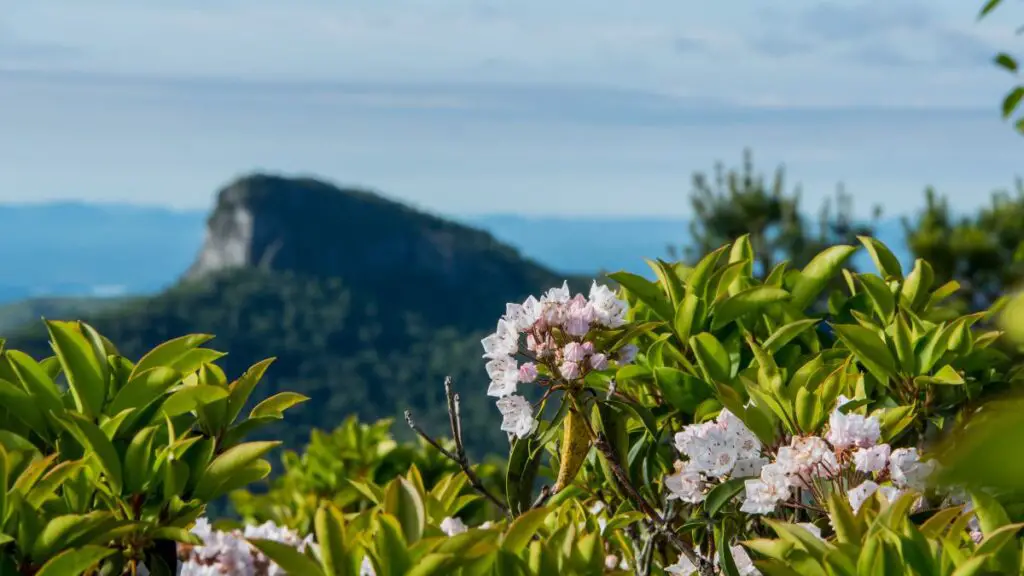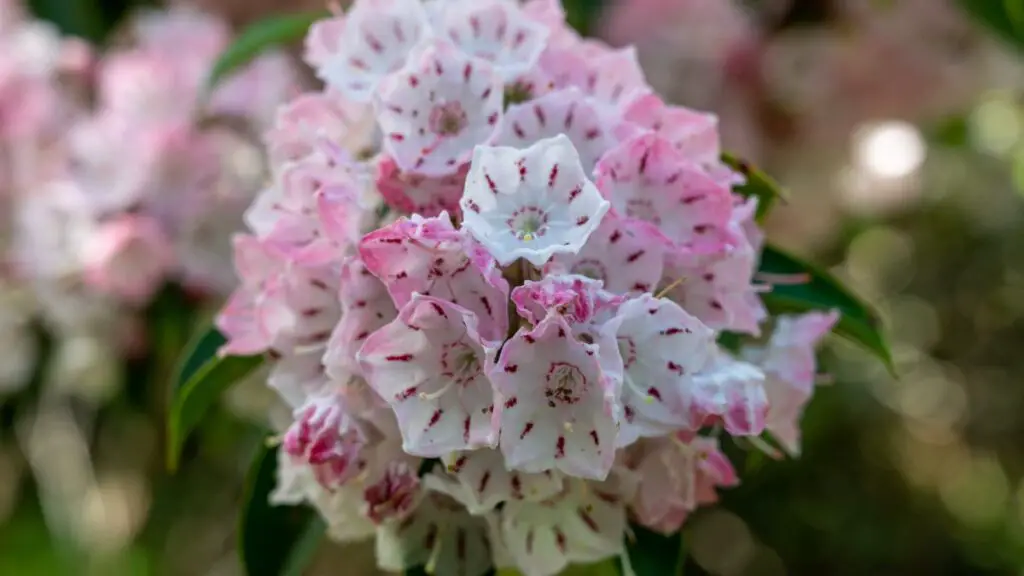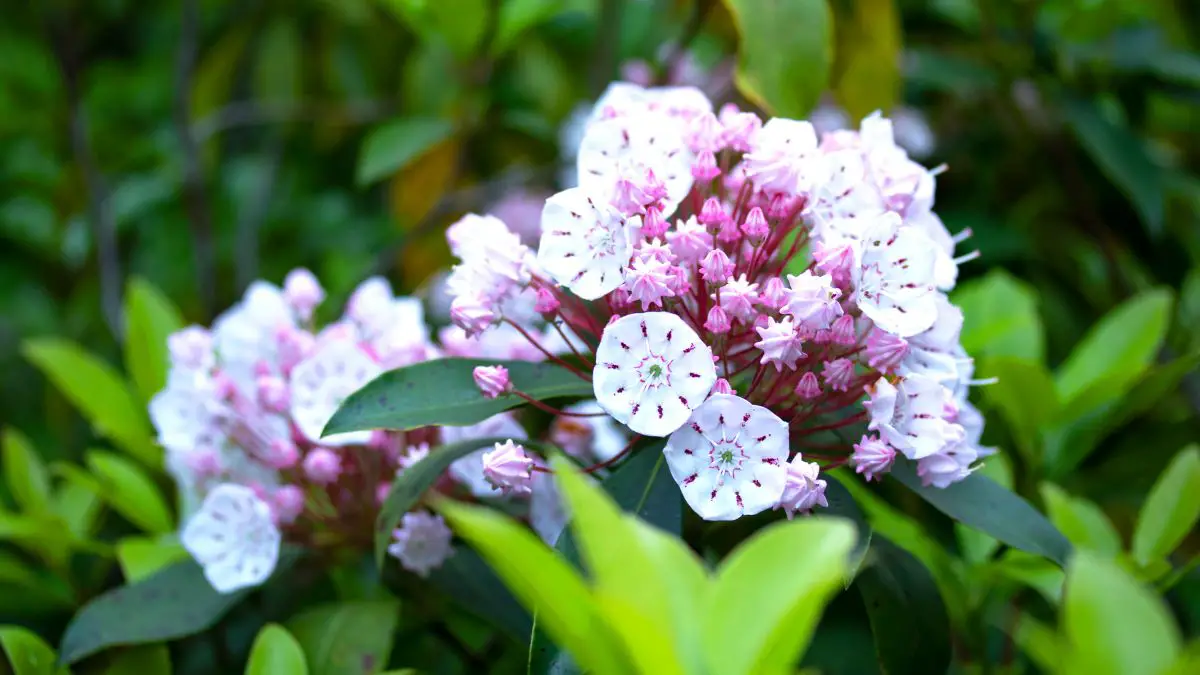Curious about when mountain laurels bloom? These vibrant flowering plants showcase their beauty in late spring to early summer, contrasting the lush greenery with their colorful blooms. Understanding the blooming season of mountain laurels can enhance your outdoor experience and appreciation of nature. Stay tuned to discover the optimal time to witness these stunning flowers in full bloom.
Key Takeaways
- Timing Matters: Mountain laurels typically bloom in late spring to early summer, so keep an eye out during this period for their beautiful flowers.
- Environmental Influences: Factors like sunlight, soil quality, and temperature can impact the flowering time of mountain laurels, so ensure they are in optimal conditions for blooming.
- Handle with Care: Be cautious as mountain laurels, the state flower tree, contain toxins that can be harmful if ingested, especially for pets and livestock.
- Safety First: When handling mountain laurels, wear gloves to prevent skin irritation and wash hands thoroughly afterwards to avoid any potential reactions.
- Appreciate from Afar: While mountain laurels have various uses in landscaping and gardening, it's essential to admire them from a distance and avoid direct contact to stay safe.
- Enjoy the Beauty: Take the time to appreciate the unique beauty of mountain laurels in bloom, whether in your garden or out in nature.
Understanding Mountain Laurels
Blooming Season
Mountain laurels typically bloom in late spring to early summer, usually between May and June. This timeframe is crucial as it marks the peak blooming period for mountain laurels. The vibrant flowers are a sight to behold during this time, attracting pollinators like bees and butterflies.
The blooming season of mountain laurels generally lasts for two to four weeks, depending on various factors such as weather conditions and plant health. During this period, the lush green mountain laurel foliage is adorned with clusters of delicate flowers in shades of pink, white, and red.
Factors Influencing Flowering
Several factors influence the flowering of mountain laurels, including sunlight exposure, soil quality, and moisture levels. Adequate sunlight is essential for healthy blooming, as it promotes photosynthesis and flower development. Conversely, excessive shade can hinder the flowering process.
External elements like temperature fluctuations and precipitation also play a significant role in determining when mountain laurels bloom. Sudden changes in temperature or prolonged periods of drought can affect the timing and intensity of flowering. Therefore, maintaining stable environmental conditions is crucial for optimal blooming.
Environmental conditions such as humidity levels and altitude can impact the flowering patterns of mountain laurels. These plants thrive in well-drained soils with moderate moisture content, ensuring that they receive sufficient nutrients for robust growth and abundant flowering.
Plant Characteristics
Mountain laurels are characterized by their evergreen shrubs with leathery leaves that have a glossy texture. These mountain laurel plants feature dense clusters of bell-shaped flowers that bloom in spring or early summer. The flowers exhibit intricate patterns and vibrant colors, making them popular ornamental plants in gardens and landscapes.
One key characteristic of mountain laurel shrubs is their ability to thrive in acidic soils with good drainage. They are known for their tolerance to deer browsing, making them ideal choices for areas with high deer populations. Mountain laurels are resistant to many pests and diseases, contributing to their low maintenance requirements.
When Do Mountain Laurels Bloom

Typical Blooming Period
Mountain laurels typically bloom in the spring months, primarily from May to June. During this period, these beautiful evergreen shrubs showcase their vibrant and delicate flowers. The blooming season is crucial for mountain laurels as it marks their reproductive phase.
The blooming period of mountain laurels plays a vital role in the ecosystem, attracting pollinators like bees and butterflies. This interaction is essential for the pollination process, ensuring the continuation of mountain laurels' growth and reproduction.
Regional Variations
The blooming patterns of mountain laurels vary significantly across different regions due to varying climatic conditions and geographical locations. In southern regions, mountain laurels tend to bloom earlier than those in northern areas.
Geographical location impacts the blooming cycle of mountain laurels, with factors such as temperature and sunlight influencing the timing of flowering. For example, mountain laurels in coastal areas may bloom earlier than those in inland regions due to milder winters.
Signs of Blooming
Visual cues play a crucial role in identifying when mountain laurels are blooming. One key indicator is the appearance of buds on the branches, which gradually open up into exquisite flowers. The vibrant colors of the flowers, ranging from pink to white, signify the onset of blooming.
Recognizing the signs that signify the flowering stage of mountain laurels involves observing changes in the plant's appearance. As the buds develop and open into full blooms, the fragrance emitted by these flowers becomes more prominent, attracting pollinators to aid in pollination.
Factors Affecting Flowering Time
Climate Impact
Mountain laurels' flowering time is heavily influenced by climate conditions. These plants thrive in regions with mild winters and moderate summers. The temperature plays a crucial role in determining when mountain laurels bloom. They are sensitive to sudden temperature shifts, which can delay or accelerate flowering.
The specific climate factors that affect mountain laurels include precipitation, humidity levels, and frost occurrences. Excessive rainfall can hinder blooming, while prolonged dry spells may also impact flowering. Mountain laurels require a delicate balance of moisture and warmth to bloom successfully.
Soil Conditions
Optimal soil conditions are essential for the healthy blooming of mountain laurels. These plants prefer acidic soils with good drainage. Rich, well-aerated soil promotes robust growth and abundant flowering in mountain laurels. The presence of organic matter in the soil enhances nutrient availability, supporting the plant's blooming cycle.
l composition directly influences the availability of essential nutrients like nitrogen, phosphorus, and potassium required for flower development. Mountain laurels thrive in soils with a pH level between 4.5 and 5.5, ensuring optimal nutrient uptake for vibrant blooms.
Sunlight Exposure
Sunlight exposure plays a critical role in the blooming process of mountain laurels. These plants require dappled sunlight or partial shade to bloom profusely. Excessive sunlight can lead to sunburn on leaves and hinder flowering, while inadequate light may result in sparse blooming.
Ideal sunlight conditions for mountain laurels involve receiving morning sunlight and being shaded during the hottest part of the day. This light exposure pattern supports healthy growth and encourages abundant flowering in these beautiful shrubs.
Toxicity in Mountain Laurels

Identifying Toxic Parts
Mountain laurels contain toxic compounds that can be harmful if ingested. To identify the toxic parts, look for leaves, flowers, and seeds. These components contain grayanotoxins, which are poisonous.
- Leaves: Shiny, dark green leaves with a leathery texture.
- Flowers: Showy clusters of pink, white, or red blossoms.
- Seeds: Small capsules containing multiple seeds.
Recognizing and avoiding these toxic parts is crucial to prevent poisoning in humans and animals.
Levels of Toxicity
The different parts of mountain laurels vary in their toxicity levels. The leaves and flowers are more toxic than the stems and roots. Ingesting even small amounts of these plants can lead to poisoning.
Exposure to toxic elements in mountain laurels can result in symptoms such as nausea, vomiting, dizziness, and difficulty breathing. Understanding the varying levels of toxicity is essential for ensuring safety around these plants.
Symptoms of Exposure
Exposure to toxic parts of mountain laurels can cause a range of symptoms in both humans and animals. Common signs of toxicity include stomach pain, drooling, weakness, and irregular heartbeat. If ingested, immediate medical attention is necessary.
- Nausea
- Vomiting
- Dizziness
- Difficulty breathing
Recognizing these symptoms promptly is vital for seeking appropriate treatment and preventing further complications from poisoning incidents.
Handling Mountain Laurels Safely
Protective Measures
To protect yourself from the toxic effects of mountain laurels, wear gloves and long sleeves when handling them. Avoid contact with the sap to minimize the risk of exposure. When working with these plants, wash your hands thoroughly afterward.
Preventive measures include keeping mountain laurels out of reach of children and pets. Educate yourself on the signs of poisoning to act quickly if necessary. Always handle these shrubs with caution to prevent any accidents.
When dealing with mountain laurels, it is crucial to take safety precautions such as wearing protective gear like goggles and masks. Ensure proper ventilation in the area where you are working with these plants. Be mindful of any allergies or sensitivities you may have.
Safe Pruning Techniques
For safely pruning mountain laurels, use sharp and clean tools to make precise cuts. Trim back branches at a 45-degree angle to promote healthy growth. Avoid cutting too close to the main stem to prevent damage.
Following correct pruning practices is essential for maintaining the health of your shrubs. Prune during the dormant season to encourage new growth in spring. Remove dead or damaged branches first before shaping the plant.
By using safe pruning methods, you can maintain healthy shrubs that bloom beautifully each year. Regularly inspect your mountain laurels for any signs of disease or pests and address them promptly. Proper pruning also helps improve air circulation within the plant.
Emergency Responses
In case of exposure to toxic parts of mountain laurels, seek medical help immediately if symptoms occur such as nausea or dizziness. Rinse affected areas thoroughly with water and avoid rubbing them.
If poisoning symptoms arise, contact emergency services right away for professional assistance. Provide details about the plant ingested and any symptoms experienced for proper treatment. Do not induce vomiting unless instructed by medical professionals.
It is crucial to remember that seeking immediate medical help in emergencies involving mountain laurels is vital for a quick recovery and minimizing potential complications.
Uses of Mountain Laurels
Traditional Applications
Mountain laurels have historically been used in traditional practices for their medicinal properties and symbolic meanings. In Native American cultures, they were utilized for treating various ailments and as a symbol of protection. The Cherokee tribe, for instance, used mountain laurel leaves to make a tea believed to soothe stomach issues and promote overall well-being. This demonstrates the cultural significance of mountain laurels in indigenous traditions.
Moreover, in European folklore, mountain laurels were associated with love and romance. They were often used in ceremonies and rituals to represent eternal love and fidelity. The traditional applications of mountain laurels extend beyond medicinal uses to encompass spiritual beliefs and customs across different cultures.
Modern Uses
In modern times, mountain laurels find contemporary applications in landscaping, gardening, and even pharmaceuticals. Their vibrant flowers and evergreen foliage make them popular choices for ornamental purposes in gardens and parks. Landscapers utilize mountain laurels to add color and texture to outdoor spaces due to their resilience and low maintenance requirements.
Furthermore, the practical uses of mountain laurels extend to the pharmaceutical industry, where certain compounds extracted from the plant are utilized in medications. These modern applications highlight the versatility of mountain laurels beyond their traditional roles, showcasing their adaptability to current practices.
Decorative Purposes
Mountain laurels are commonly utilized for decorative purposes due to their aesthetic value and visual appeal. Their clusters of delicate blooms in shades of pink, white, or red enhance the beauty of gardens and landscapes. Gardeners often incorporate mountain laurels into their designs to create focal points or borders that attract butterflies and hummingbirds.
The role of mountain laurels in enhancing outdoor decor goes beyond aesthetics; they also contribute to creating natural habitats for wildlife by attracting pollinators. Their evergreen nature ensures year-round interest in garden settings. Overall, the decorative purposes of mountain laurels play a crucial role in elevating the visual appeal of outdoor spaces.
Final Remarks
Understanding the blooming patterns of mountain laurels is essential for their care and appreciation. Knowing the factors influencing their flowering time and the precautions to take due to their toxicity will help you handle these plants safely. Whether for landscaping or medicinal purposes, mountain laurels offer various uses worth exploring.
As you delve into the world of mountain laurels, remember to observe their bloom times, consider safety measures, and make the most of their versatile nature. Share your newfound knowledge with fellow enthusiasts and continue to learn about the fascinating aspects of these beautiful plants.
Frequently Asked Questions
When is the best time to view mountain laurels in bloom?
Mountain laurels typically bloom in late spring to early summer, usually around May to June. This period may vary slightly depending on the specific climate and location. The peak bloom time is a visually stunning experience not to be missed.
How long do mountain laurel flowers last?
The beautiful blooms of mountain laurels can last for several weeks, providing an extended period of vibrant color and beauty in your garden or natural surroundings. Enjoy the picturesque display while they are in full bloom during late spring through early summer.
Do all varieties of mountain laurels bloom at the same time?
Different varieties of mountain laurels may have slight variations in their blooming times. Factors such as climate, sunlight exposure, and specific species can influence when each plant begins to flower. Understanding these nuances can help you appreciate the diversity within this stunning plant family.
Can I encourage my mountain laurel to bloom earlier?
While you cannot drastically change the blooming time of mountain laurels, ensuring optimal growing conditions such as proper sunlight, soil moisture, and nutrients can promote healthy growth and potentially lead to earlier blooms. However, nature largely dictates the timing of these delightful flowers.
What colors do mountain laurel flowers come in?
Mountain laurel flowers exhibit a range of colors including shades of pink, white, and even light purple. The diverse color palette adds visual interest and charm to these blossoms, making them a popular choice for landscaping and enhancing natural environments with their unique hues.
Image Source: Paid image from CANVA




